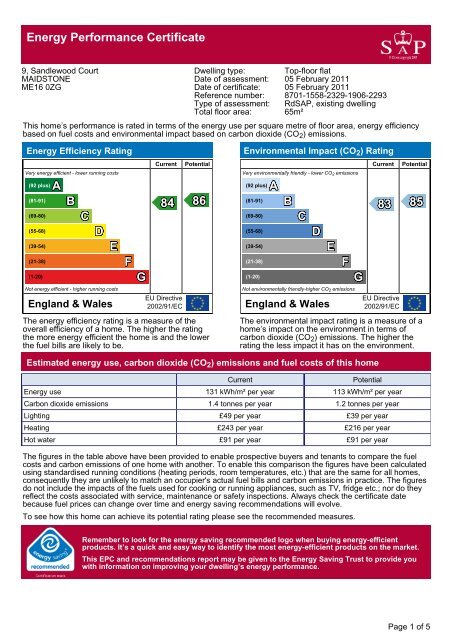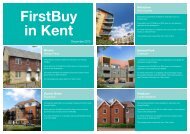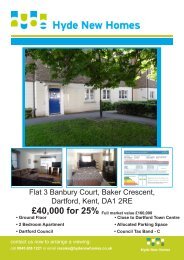Energy Performance Certificate AAAA BBBB CCCC DDDD EEEE ...
Energy Performance Certificate AAAA BBBB CCCC DDDD EEEE ...
Energy Performance Certificate AAAA BBBB CCCC DDDD EEEE ...
Create successful ePaper yourself
Turn your PDF publications into a flip-book with our unique Google optimized e-Paper software.
About this documentThe <strong>Energy</strong> <strong>Performance</strong> <strong>Certificate</strong> for this dwelling was produced following an energy assessment undertakenby a qualified assessor, accredited by Quidos, to a scheme authorised by the Government. This certificate wasproduced using the RdSAP 2005 assessment methodology and has been produced under the <strong>Energy</strong><strong>Performance</strong> of Buildings (<strong>Certificate</strong>s and Inspections) (England and Wales) Regulations 2007 as amended. Acopy of the certificate has been lodged on a national register.Assessor’s accreditation number: QUID200256Assessor’s name:Stephen SalterCompany name/trading name: Steve Salter - DEAAddress:23 Camomile Drive, Weavering, Maidstone, KentME14 5FLPhone number: +44 01622 730633Fax number:E-mail address:stevesalterdea@live.co.ukRelated party disclosure:No related partyIf you have a complaint or wish to confirm that the certificate is genuineDetails of the assessor and the relevant accreditation scheme are as above. You can get contact details of theaccreditation scheme from their website at www.quidos.co.uk together with details of their procedures forconfirming authenticity of a certificate and for making a complaint.About the building’s performance ratingsThe ratings on the certificate provide a measure of the building’s overall energy efficiency and its environmentalimpact, calculated in accordance with a national methodology that takes into account factors such as insulation,heating and hot water systems, ventilation and fuels used. The average <strong>Energy</strong> Efficiency Rating for a dwellingin England and Wales is band E (rating 46).Not all buildings are used in the same way, so energy ratings use ‘standard occupancy’ assumptions which maybe different from the specific way you use your home. Different methods of calculation are used for homes andfor other buildings. Details can be found at www.communities.gov.uk/epbd.Buildings that are more energy efficient use less energy, save money and help protect the environment. Abuilding with a rating of 100 would cost almost nothing to heat and light and would cause almost no carbonemissions. The potential ratings on the certificate describe how close this building could get to 100 if all the costeffective recommended improvements were implemented.About the impact of buildings on the environmentOne of the biggest contributors to global warming is carbon dioxide. The way we use energy in buildings causesemissions of carbon. The energy we use for heating, lighting and power in homes produces over a quarter of theUK’s carbon dioxide emissions and other buildings produce a further one-sixth.The average household causes about 6 tonnes of carbon dioxide every year. Adopting the recommendations inthis report can reduce emissions and protect the environment. You could reduce emissions even more byswitching to renewable energy sources. In addition there are many simple everyday measures that will savemoney, improve comfort and reduce the impact on the environment. Some examples are given at the end of thisreport.Click www.epcadviser.direct.gov.uk our online tool which uses information from this EPC to show youhow to save money on your fuel bills.Further information about <strong>Energy</strong> <strong>Performance</strong> <strong>Certificate</strong>s can be found under Frequently Asked Questions atwww.epcregister.comiQ-<strong>Energy</strong> v1.0.2 (SAP 9.83) Page 2 of 5
Recommended measures to improve this home’s energy performance9, Sandlewood CourtMAIDSTONEME16 0ZGDate of certificate: 05 February 2011Reference number: 8701-1558-2329-1906-2293Summary of this home’s energy performance related featuresThe table below gives an assessment of the key individual elements that have an impact on this home’s energyand environmental performance. Each element is assessed by the national calculation methodology against thefollowing scale: Very poor / Poor / Average / Good / Very good. The assessment does not take intoconsideration the physical condition of any element. ‘Assumed’ means that the insulation could not be inspectedand an assumption has been made in the methodology based on age and type of construction.ElementDescription<strong>Energy</strong> EfficiencyCurrent performanceEnvironmentalWalls Timber frame, as built, insulated (assumed) Good GoodRoof Pitched, 100 mm loft insulation Average AverageFloor (other premises below) - -Windows Fully double glazed Good GoodMain heating Boiler and radiators, mains gas Very good Very goodMain heating control Programmer, room thermostat and TRVs Good GoodSecondary heating None - -Hot water From main system Very good Very goodLighting Low energy lighting in 75% of fixed outlets Very good Very goodCurrent energy efficiency rating B 84Current environmental impact (CO 2)rating B 83Low and zero carbon energy sourcesNonePage 3 of 5
RecommendationsThe measures below are cost effective. The performance ratings after improvement listed below are cumulative,that is they assume the improvements have been installed in the order that they appear in the table.Lower cost measures (up to £500)Typical savings peryear<strong>Performance</strong> ratings after improvement<strong>Energy</strong> efficiencyEnvironmental impact1 Increase loft insulation to 270 mm £29 B 85 B 852 Low energy lighting for all fixed outlets £9 B 86 B 85Total £38Potential energy efficiency rating B 86Potential environmental impact (CO 2) rating B 85Further measures to achieve even higher standardsNoneImprovements to the energy efficiency and environmental impact ratings will usually be in step with each other.However, they can sometimes diverge because reduced energy costs are not always accompanied by areduction in carbon dioxide (CO 2)emissions.Page 4 of 5
About the cost effective measures to improve this home’s performance ratingsIf you are a tenant, before undertaking any work you should check the terms of your lease and obtain approvalfrom your landlord if the lease either requires it, or makes no express provision for such work.Lower cost measures (typically up to £500 each)These measures are relatively inexpensive to install and are worth tackling first. Some of them may be installedas DIY projects. DIY is not always straightforward, and sometimes there are health and safety risks, so takeadvice before carrying out DIY improvements.1 Loft insulationLoft insulation laid in the loft space or between roof rafters to a depth of at least 270 mm will significantly reduceheat loss through the roof; this will improve levels of comfort, reduce energy use and lower fuel bills. Insulationshould not be placed below any cold water storage tank, any such tank should also be insulated on its sides andtop, and there should be boarding on battens over the insulation to provide safe access between the loft hatchand the cold water tank. The insulation can be installed by professional contractors but also by a capable DIYenthusiast. Loose granules may be used instead of insulation quilt; this form of loft insulation can be blown intoplace and can be useful where access is difficult. The loft space must have adequate ventilation to preventdampness; seek advice about this if unsure. Further information about loft insulation and details of localcontractors can be obtained from the National Insulation Association (www.nationalinsulationassociation.org.uk).2 Low energy lightingReplacement of traditional light bulbs with energy saving recommended ones will reduce lighting costs over thelifetime of the bulb, and they last up to 12 times longer than ordinary light bulbs. Also consider selecting lowenergy light fittings when redecorating; contact the Lighting Association for your nearest stockist of Domestic<strong>Energy</strong> Efficient Lighting Scheme fittings.About the further measures to achieve even higher standardsNot applicableWhat can I do today?Actions that will save money and reduce the impact of your home on the environment include:Ensure that you understand the dwelling and how its energy systems are intended to work so as to obtainthe maximum benefit in terms of reducing energy use and CO 2 emissions.Check that your heating system thermostat is not set too high (in a home, 21°C in the living room issuggested) and use the timer to ensure you only heat the building when necessary.Turn off lights when not needed and do not leave appliances on standby. Remember not to leavechargers (e.g. for mobile phones) turned on when you are not using them.Close your curtains at night to reduce heat escaping through the windows.If you’re not filling up the washing machine, tumble dryer or dishwasher, use the half-load or economyprogramme.For advice on how to take action and to find out about offers available to help make your home more energyefficient, call 0800 512 012 or visit www.energysavingtrust.org.uk.Page 5 of 5
















